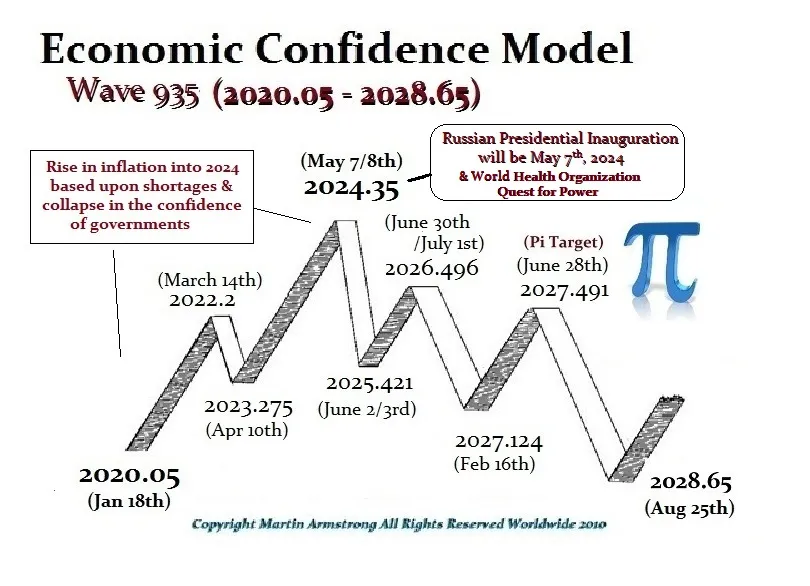 REPLY: On Sepetember 2nd, 2023, we warned on the private blog that the “real estate market, 2023 should produce the highest annual closing.” With the ECM turning down into 2028 and war on the horizon, what New York has done to Trump is a warning to get the hell out of New York. This decision was as bad as putting sanctions on Russia, which became a warning to everyone else: if you do not do as the American Neocons command, they will remove you from the SWIFT system.
REPLY: On Sepetember 2nd, 2023, we warned on the private blog that the “real estate market, 2023 should produce the highest annual closing.” With the ECM turning down into 2028 and war on the horizon, what New York has done to Trump is a warning to get the hell out of New York. This decision was as bad as putting sanctions on Russia, which became a warning to everyone else: if you do not do as the American Neocons command, they will remove you from the SWIFT system. This event in New York City will send tremors throughout the nation. Commercial Real Estate (CRE) peaked on our models in 2020 in REAL TERMS with COVID. Ever since the need for office space has taken a nosedive, as I have said, if I were Trump, I would have handed them an office building for the fine and then bought it back at 10% when they auctioned it off. With its political vendetta against Trump, New York has only made New York City the leader in the decline, and we have NOT seen the bottom yet. This will send panic among the smart people, and this will cause further contagion to spread to residential property, which has been propped up because of jobs in New York City, which we still show are in crash mode into 2028/2029.
This event in New York City will send tremors throughout the nation. Commercial Real Estate (CRE) peaked on our models in 2020 in REAL TERMS with COVID. Ever since the need for office space has taken a nosedive, as I have said, if I were Trump, I would have handed them an office building for the fine and then bought it back at 10% when they auctioned it off. With its political vendetta against Trump, New York has only made New York City the leader in the decline, and we have NOT seen the bottom yet. This will send panic among the smart people, and this will cause further contagion to spread to residential property, which has been propped up because of jobs in New York City, which we still show are in crash mode into 2028/2029.
–
Banks’ CRE loan books’ primary concern is exposure to the office and retail sectors. Based on our sources, we would estimate that banks’ CRE lending financed 46% of office and retail loans which most likely comes in between $700-725 billion. Added to this concern is the concentration of CRE loans on the balance sheets of regional banks. It appears that CRE loans on the books of regional banks amount to about 65% of non-multifamily CRE loans. After this auction, many banks are going to be deeply concerned about the realistic valuation of CRE properties. The risk is that this will further undermine the belief in bank stability going forward.
–
Smaller regional banks will most likely pull back from CRE, which will undermine values going forward. Large banks or insurance companies are unlikely candidates to start lending into the CRE sector. The more likely lenders into CRE will probably be private credit investors, but that will also come at higher rates. The total CRE market is valued at over $10 trillion, with the office sector being the largest sector at around 24-25%.
–
Refinancing Challenges for CMBS
–
There there is the Commercial Mortgage-Backed Securities (CMBS) market that accounts for 20% of the office and retail loans. That comes in around $300 billion+, of which about $22 billion in office loans maturing here in 2024. Typically, up to 50% of that would not be a problem to roll. However, after this sale at auction, many will have second thoughts. Our sources place about 95% of those loans are only backed by Class B and Class C offices. This auction will weaken the funding potential for the lower-quality buildings, and this will accelerate the risk of strategic default into especially 2026.
–
When we dig deeper, the 60-day-plus delinquency rate is only about 10%, but it is rising rapidly. This implies that we should expect more stress in the CMBS market between now and 2026. The vacancy rate in major cities nationwide is approaching 20%. In the case of New York City, this particular building had a vacancy rate of about two-thirds. The rents they collected from the remaining tenants were not even enough to cover the ground lease, no less the taxes and upkeep of the building. The losses were catastrophic, especially since they indicted Trump in New York City.

On top of all of that, then you have the flight from the Democratic Blue States to the Red Republican States post-COVID. We addressed the Commerical Real Estate on June 8th, 2023. Where vacancy rates in San Francisco were approaching 30%, in Miami they were the lowest nationally at just 15.8%. We wrote back then:
–
“During the first quarter of 2023, U.S. office vacancy topped 20% nationally for the first time really since the Great Depression. Then there are cities that have embraced WOKE to their detriment and are witnessing the worst. In San Francisco, the vacancy rate in the first quarter of 2023 climbed to 29.4%, up from 27.6% in the fourth quarter of 2022. Manhattan has a vacancy rate of n the first quarter of 2023 at 22.2% according to Cushman & Wakefield. Dallas has been absorbing the flight from California so its vacancy rate is 18.7% according to Cushman & Wakefield. The commercial vacancy rate in Miami, Florida office market has an overall vacancy which has been declining counter-trend to the rest of the nation falling now to 15.8% according to Cushman & Wakefield. In Chicago, Class-A vacancy rate stands at 19.3% while Class-B vacancy jumped to 28.3% according to Cushman & Wakefield.”
–

